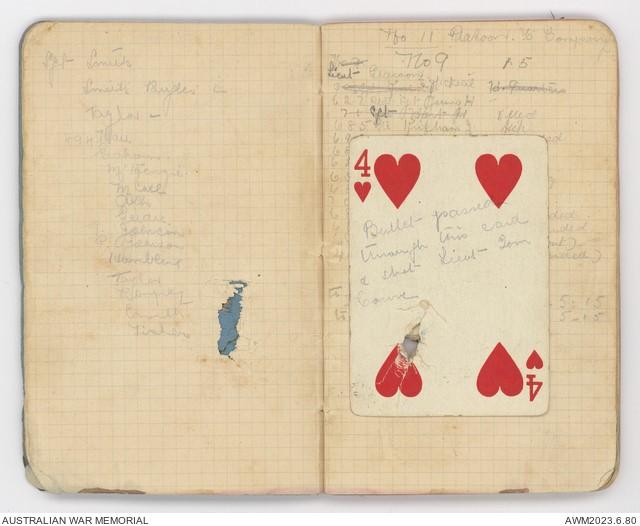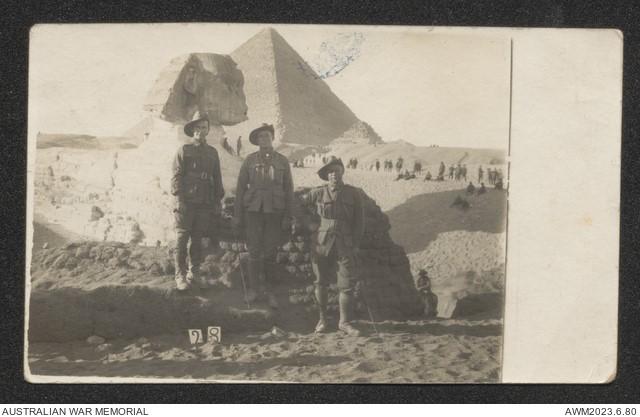New in the First World War Galleries
On your next visit to the Australian War Memorial you may notice some different items in Australia in the Great War, the Memorial’s First World War galleries. Fourteen new objects from the Research Centre’s collections have been placed on display. The items include the personal diaries of soldiers and nurses, the hand-recorded roll of the 1st Royal Australian Naval Bridging Train, concert party programs, embroidered postcards, and the military pilot licence of the distinguished aviator Captain Ross Macpherson Smith.
Hand drawn program for the 4th Brigade Concert Party, held in France on 14 July 1917. PUBS002/004/001/023/001
These rare and original objects have replaced other Research Centre collections that are due to be rested to ensure their long-term preservation, as exposure to light can cause fading over time.
Below are two highlights from the latest Research Centre collections on display.
Gallipoli notebook and playing card of Lieutenant Alfred Glasson

The damaged notebook and playing card belonging to Lieutenant Alfred Glasson. PR90/085
The notebook, from PR90/085, was used on Gallipoli by Lieutenant Alfred Glasson of the 8th Battalion to record notes on supplies, casualties and the men in his platoon. A 32-year-old journalist from Minyip in Victoria, Glasson had enlisted in the Australian Imperial Force in August 1914. He embarked for Egypt in October and spent four months training in the desert, before his unit landed at Gallipoli as part of the second wave on 25 April 1915.
Glasson was commissioned an officer the day after the landing and, over the following three months, his battalion was committed to the attack on Krithia and to the defence of the Anzac beachhead. Glasson used the notebook during this period, his brief notes keeping track of the casualties and movements in each of the sections under his platoon.

Then Lance Corporal Glasson (centre) with Private Stan Craig (left) and Corporal Austin Frauenfelder in Egypt in January 1915. PR90/085
During the August Offensive, Glasson’s battalion occupied the trenches around Courtney’s and Steele’s Posts, just to the north of Lone Pine. The battalion’s position was meant to be quieter at this time, with the main fighting taking place at Lone Pine, Suvla Bay and Chunuk Bair. Yet, on 8 August, the 8th Battalion’s war diary records that the unit was subject “all night [to] much rifle and shell fire”. A bullet or a piece of shrapnel struck Glasson, passing through the notebook and fatally wounding him. He died near Steele’s Post. Poignantly, the projectile had also pierced the four of hearts playing card interleaved in the pages of Glasson’s notebook.
Glasson’s damaged notebook and the playing card are part of the August Offensive display in Australia in the Great War.
Salonika diary of Staff Nurse Laura Grubb
Staff Nurse Laura Grubb (left) with David Sharpie and Sister Brij Martin in Salonika, Greece, in 1917. P02198.003
The diary of Staff Nurse Laura Grubb, containing vivid detail of her experiences nursing in Salonika, Greece, has been placed on display in the 1918 section of Australia in the Great War. Grubb, a 33-year-old nurse from Launceston, Tasmania, had been eager to contribute to the war effort. Her application to join the Australian Army Nursing Service was accepted in May 1917 and she embarked from Melbourne the following month as part of a contingent of 215 nurses.
Were it not for the war, the nurses’ voyage would have been almost idyllic. Writing to her mother, Grubb described the “magnificent buildings” of Colombo, her impressions of Bombay and, on arriving in Egypt, her adventures around Cairo. But the thrill of wartime tourism soon wore thin, and Grubb wrote of her eagerness to “get to work in earnest.” The nurses eventually departed Alexandria in August, bound for Salonika in the Macedonia region of Greece.

Salonika harbour in circa 1917, from a photograph album kept by Staff Nurse Grubb. PR83/040
The Australian nurses were attached to British hospitals at Hortiach, Kalamaria and Uchanta, Grubb serving with No. 42 and later No. 60 General Hospital. Conditions in Salonika were harsh. The winters were icy, the accommodation crowded and sparse, and fresh food was in short supply. The nurses drew rations like the soldiers, and Grubb recorded in her diary the myriad ways in which bully beef was served – minced, warmed, with potatoes or rice, with hash, stewed, or with biscuits. She reserved particular disdain, though, for marmalade, at one point “wish[ing] all the marmalade ships wd go down”. Despite the food and the conditions, Grubb remained dedicated to her work. She showed particular concern for the “physical wrecks”: the dishevelled and exhausted men sent back from the front with malaria.
Grubb spent eighteen months nursing in Salonika. She embarked for home in March 1919, four months after the end of the war. The influenza pandemic had now spread to Australia and, until her discharge in July, Grubb spent her time caring for returning soldiers in Hobart.
Grubb’s diary was donated to the Memorial, as part of PR83/040, by her family in 1983. She had died four years earlier, at age 94.

